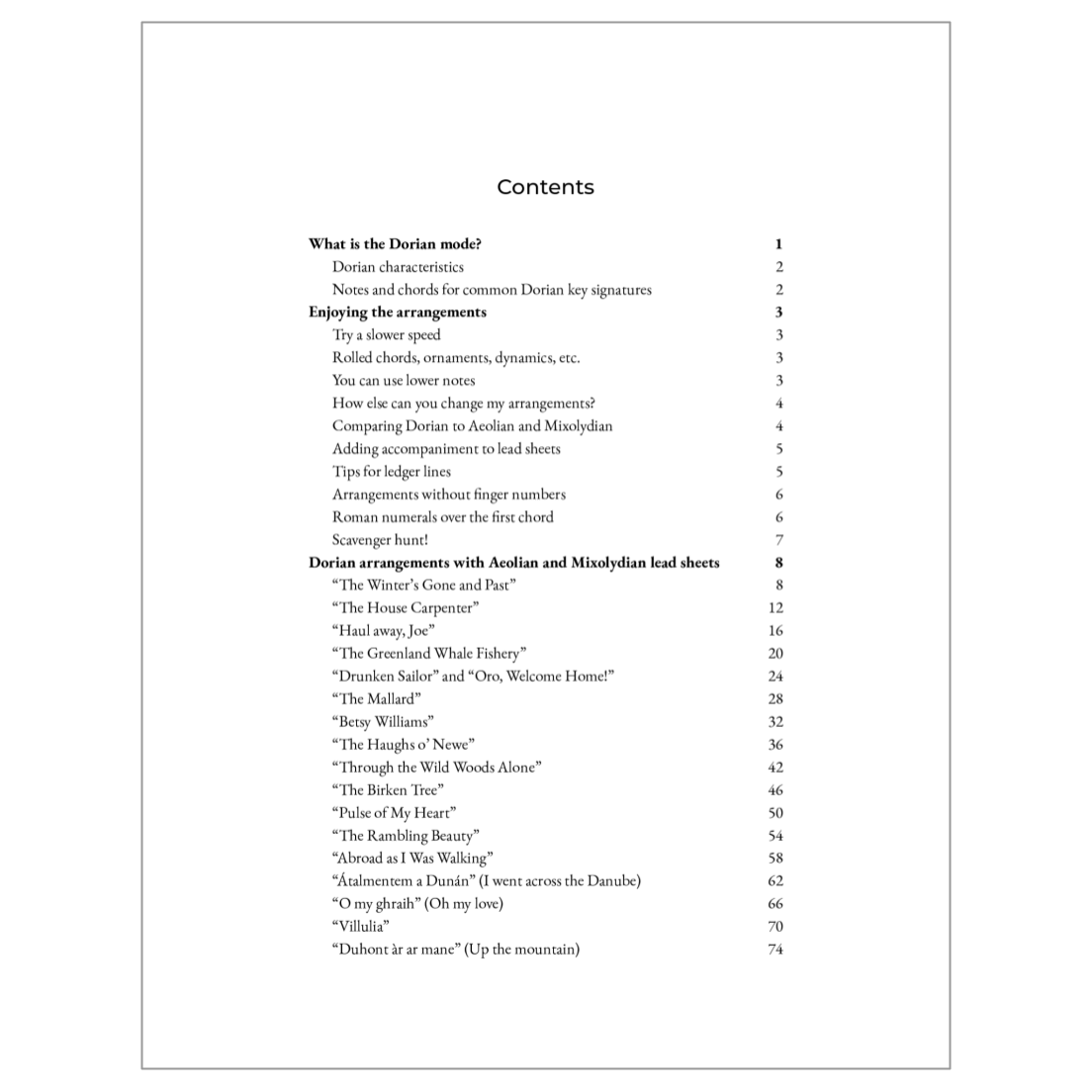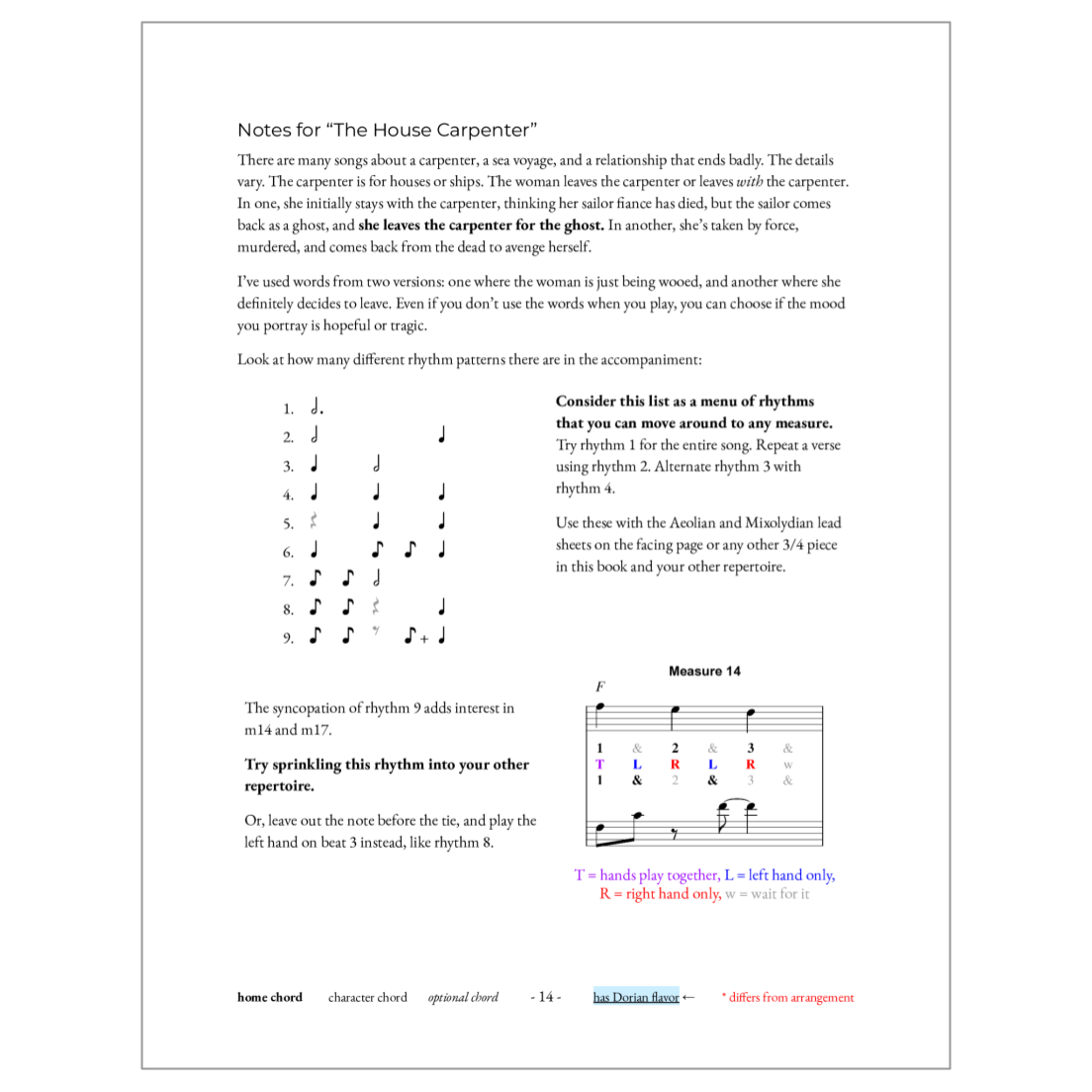Enjoy the Dorian Mode Book (SPIRAL-BOUND)
Enjoy the Dorian Mode Book (SPIRAL-BOUND)
26 Dorian arrangements of “olde” songs from 11 regions. Each song is also transformed into a Mixolydian version and an Aeolian version. Lyrics, chord symbols, and historical background provided for each song. 137 pages. Spiral-bound.
(The “Damaged cover” option is from a shipment of books that arrived in a box with one edge completely smashed in. The books are 100% usable, they just have a crumpled corner.)
This is the U.S. hard copy version. You have two other options for obtaining this book:
26 Dorian arrangements from the days of yore
Sea shanties, Gregorian chants, troubadour ballads, folk songs, a folk dance, a slow air, sacred harp, and more. I’ve selected 26 Dorian pieces written over the course of over 700 years, then arranged them with the benefit of another century of music scholarship.
All arrangements include lyrics and chord symbols. Most of the arrangements fit on two pages.
Plus 26 Aeolian and 26 Mixolydian lead sheets
Every Dorian arrangement is followed by Aeolian and Mixolydian lead sheets for you to compare, differentiate, and add to your modal repertoire.
Musicians often think of modes on a scale from light to dark using the acronym LIMDAP: Lydian, Ionian, Mixolydian, Dorian, Aeolian, Phrygian. To help you distinguish Dorian from Aeolian, the mode that is one degree darker on the LIMDAP scale, I’ve included Aeolian lead sheets in D Aeolian (one flat). Because there is only one note that is different between D Aeolian and D Dorian (B versus B♭), comparing the Aeolian and Dorian melodies and chords helps you train your ear to that special Dorian sound.
In the other direction, I’ve included lead sheets in D Mixolydian (one sharp). As with Aeolian, there is only one note that is different between D Mixolydian and D Dorian (F♯ versus F). This is the note that distinguishes the major Mixolydian mode from the minor Dorian mode, so it is much easier to discern than Aeolian versus Dorian. Including the Mixolydian lead sheets is a fun, not-hard way to increase your modal repertoire.
Compare with your ear
Each set of three clips take you through the same piece in D Aeolian (D E F G A B♭ C), then D Dorian (D E F G A B C), then D Mixolydian (D E F♯ G A B C). The images of the scores above show how you can see those differences in the colors and fonts as you play and listen to all of the arrangements and lead sheets.
Historical background and tips for playing
Each song is followed by one or two pages of notes. These notes contain some information about the song’s history…
…some aspect of the arrangement that you could use for arranging other songs or altering the pieces in this book…
…as well as tips for memorization and performance, plus recommendations for making my arrangement easier or more challenging.
The complete list of songs
“Abroad as I Was Walking.” Ballad, England. “‘I’ll dress myself in men’s attire, with trousers white as snow. Till I find out my own true love, to the raging seas I’ll go.’”
“A chantar” (If you weren’t such a jerk, I wouldn’t have had to sing this). Medieval France (Occitania). Lyrics in Provençal. See the image above with the old manuscript.
“A l’entrant d’este” (At the entrance of summer) chanson, medieval France (Occitania). Lyrics in langue d’oil. Read a whole article about this song, with a translation by Frédéric EFFE➚.
“Amhrán na leabhar” (The song of the books) slow air, Ireland. Lyrics in Gaelic.
“Átalmentem a Dunán” (I went across the Danube) folk song, Hungary. Lyrics in Hungarian.
“Ave maris stella” (Hail, star of the sea) solemn tone Gregorian chant. “Hail, star of the sea … happy gate of heaven.” Lyrics in Latin with English translations.
“Betsy Williams.” Ballad, England. “Oh when I wore my apron low, my love followed me through frost and snow. But now I wear it up to my chin, oh he passes by and he says nothing.”
“The Birken Tree.” Ballad, Scotland. “O never mind your mammy’s yell. Nae doubt she’s met your dad hersel’.”
“Cambridge Short Tune” psalm tune, England. “Make haſt to me Lord, for I poore am & needy: Thou art mine ayd, & my helper O Lord; doe not tarry.”
Cantiga 321 (“The girl who was cured of scrofula”). From the Cantigas de Santa Maria, medieval Spain (Galicia). Not to worry: the title gives away the ending. Lyrics in medieval Galician-Portuguese.
“Drunken Sailor.” Shanty, Ireland. I’ve combined this with “Oro, Welcome Home!,” the air that it is likely created from.
“Duhont àr ar mane” (Up on the mountain) hanter dro, Brittany. Lyrics in Breton.
“The Greenland Whale Fishery.” Sea song, West Indies. “Our finger-tops were frozen off, and likewise our toenails as we crawled on the deck, my boys, looking out for the Greenland whale, and sing, ‘What cheer, yo ho!’”
“The Haughs o’ Newe.” Ballad, Scotland. “And could I get your own consent and syne had you upon my pony, I would nae mair range through a fair but stay at hame wi’ my love, Downie.”
“Haul away, Joe.” Shanty, England. “King Louis got his head cut off and spoiled his Constitution.”
“The House Carpenter.” Ballad, England/Scotland/United States. “I’ve four and twenty mariners on board; you shall have music at your command.”
“Jesu dulcis memoria” (Sweet memory of Jesus) Gregorian chant. “Tongue cannot speak, pen cannot write; experience alone can believe, what it is to love Jesus.” Lyrics in Latin with English translations.
“The Mallard.” A country dance, Brittany/England. “Aloft the planets never give over, dancing, circling round the sun.”
“O my ghraih” (Oh my love) song, Isle of Man. “And if I’ll not get my own heart’s love with me, then I must die bereft of thee.” Lyrics in Manx and English.
“Oro, Welcome Home!” Hauling home song, Ireland. This is the original air from which “Drunken Sailor” was created. Lyrics in Gaelic.
“Pulse of My Heart.” Air, Ireland. “Look down from your sphere on mine, love, and smile, tho’ I may not see your face till we meet in the sunrise glad of immortality.”
“The Rambling Beauty.” Ballad, Scotland. “‘Be gone,’ said she, ‘you young prating fellow. How dare you now come to trouble me? Go wear a bunch of the cold green willow…’”
“Regina clemencie” (O queen of clemency) medieval England. “You who are inviolate are thus called violet.” Lyrics in medieval Latin.
“The Sheep Under the Snow” (Ny kirree fo niaghtey) ballad, Isle of Man. Lead sheet only, provided as part of an exercise; no lyrics.
“Sum in aliena provincia” (In a foreign land) XLV from Piae Cantiones, Finland/Sweden. “I have been expelled from my land. I am destroyed in anguish.” Lyrics in medieval Latin.
“Through the Wild Woods Alone.” Whistle tune, Ireland. “I’ve a home in the woods, the dark green woods, neath shades of the old oak tree…”
“Villulia” sacred harp, United States. “Many for his crying chide him, but he call’d the louder still…”
“The Winter’s Gone and Past.” Ballad, England/Ireland/Isle of Man/Scotland. “His [love] is like the moon that wanders up and down and at every month’s end it is new.”
Why no “Scarborough Fair?”
My goal is to increase your Dorian repertoire, so I purposely did not arrange Dorian pieces that you might already have. Some popular Dorian pieces that have been beautifully arranged by other harpers include “Arran Boat Song,” “The Chanter’s Tune,” O’Carolan’s “Grace Nugent,” “Lamento di Tristan,” “La Rotta,” “Scarborough Fair,” and “Wondrous Love.”
If those tunes are new to you, I encourage you to search for the titles on Melody’s➚, Sylvia Woods’s site➚, Harp Column Music➚, or your favorite music store. Those tunes are in the public domain, so you can likely find a free version of the melodies at the Traditional Tune Archive➚, the International Music Score Library Project➚, or via a general internet search.
What level is this book?
Enjoy the Dorian Mode has Dorian arrangements in D Dorian (no flats or sharp). There are lead sheets in D Aeolian (B♭), D Mixolydian (F♯), and D Ionian (F♯ and C♯). The lowest note in the arrangements is C below middle C. The highest note is three Es above middle C. This fits a 24-string harp that starts on the C below middle C.
I arranged the songs for harp, and I chose keys that allow a harper to keep their hands on the same strings for the melody. If you play another instrument, expand the small images at the top of the page to look at the sample arrangement pages, and see if they would work on your instrument. All arrangements include chord symbols. There are lyrics for vocalists.
From a harping perspective, the arrangements are advanced beginner through intermediate. Both hands play independently. There are some three-note and four-note chords in the left hand, but almost no chords in the right hand. There are cross-unders and syncopation. There are no brackets or finger numbering; I highly recommend Harp Fingering Fundamentals➚ by Sylvia Woods.
I give ample permission in the introduction and throughout the book for you to alter my arrangements as you like. Because the arrangements have chord symbols, it’s possible to ignore the accompaniment rhythm and play simply one beat per measure using the note listed in the chord symbol.
If you’re not sure if Enjoy the Dorian Mode is right for you right now, email me with your concerns, and I'm happy to answer what I can or recommend a more appropriate resource for what you’re looking for. Check out my list of free modes resources, which has links to videos and other books.
What people are saying about Enjoy the Dorian Mode
“…an excellent resource for any musician seeking to expand his/her repertoire with unexpected musical gems… Karen encourages each person’s own creativity and adaptation based on her/his own needs…” — Anna Belle O’Shea, CMP, flutist and pianist, student of harp
“…Karen has taken a serious, yet fun, approach to what may be the least well known of the four commonly used modes…” — Ivan Bradley, multi-instrumentalist
“…I love this collection because you could just play the songs and have nice additions to your repertoire or play and expand your knowledge of the Dorian mode at the same time!!!…” — Robbin Gordon-Cartier➚, harp teacher, performer, and presenter
“…a comprehensive tutorial in understanding and crafting arrangements with a modal feel… Although arranged for harps, this book is a valuable resource for anyone interested in modal music. Karen uses whimsical comparisons and suggestions to create context and build musical skills… Highly recommended!” — Karen Ashbrook, CMP, creator of the Mystery of Modes workshops➚ and Dulcimer with Heart➚









